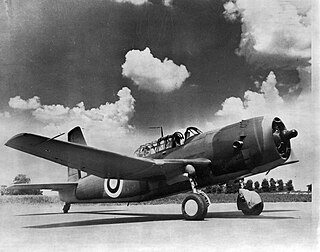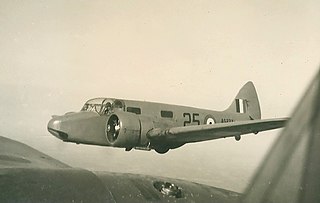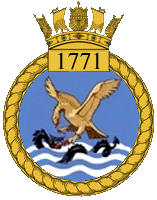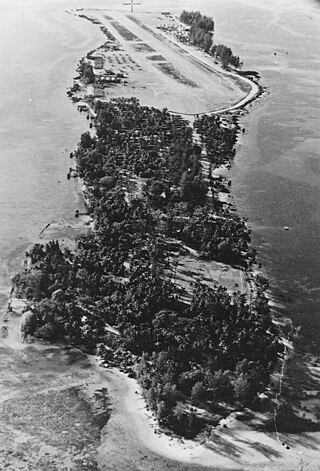
Royal Air Force Kai Tak or more commonly RAF Kai Tak is a former Royal Air Force station situated in Hong Kong, at Kai Tak Airport, Kowloon. It was established by the Royal Air Force (RAF) in 1927 and used for seaplanes. The RAF flight operated a few land based aircraft as well as having spare aircraft for naval units.

The Sembawang Air Base is a military airbase of the Republic of Singapore Air Force (RSAF) located at Sembawang, in the northern part of Singapore. The base motto is Swift and Resolute.

The Mobile Naval Airfield Organisation (MNAO) was the shore-based component of the naval air logistics organisation. This comprised two types of units, a Mobile Operational Naval Air Base (MONAB) and a Transportable Aircraft Maintenance Yard (TAMY). These were mobile units, the first of which formed in 1944, to provide logistical support to the Fleet Air Arm squadrons of the Royal Navy's British Pacific Fleet, towards the end of World War II.
HMS Nabberley was a Royal Navy (RN), Mobile Operational Naval Air Base (MONAB) at the Royal Australian Air Force (RAAF) base RAAF Bankstown in Sydney, Australia. HMS Nabberley was also known as MONAB II and Royal Naval Air Station Bankstown.

778 Naval Air Squadron was a Fleet Air Arm (FAA) naval air squadron of the United Kingdom’s Royal Navy (RN). During the Second World War the squadron was a Service Trials Unit (STU) initially based at HMS Daedalus, RNAS Lee-on-Solent, Hampshire, England before moving to HMS Condor, RNAS Arbroath, Angus, Scotland on 6 July 1940. The squadron tested all types of aircraft that could be used by the Royal Navy. Key to this was testing new types for deck landing on aircraft carriers. Such aircraft included various types of Supermarine Seafires, Grumman Hellcats, Grumman Martlets, Grumman Avengers, and Vought Corsairs. The squadron was reformed on 5 November 1951 with Douglas Skyraider AEW.1 but was disbanded on 7 July 1952 to form the basis of 849 Naval Air Squadron.

706 Naval Air Squadron was a Fleet Air Arm (FAA) naval air squadron of the United Kingdom’s Royal Navy (RN). Established as a fighter and torpedo-bomber training unit in Australia at the end of World War Two, it was briefly reformed as a helicopter squadron in the early 1950s, before becoming a helicopter training unit in 1962, and operating until 1998.

895 Naval Air Squadron was a Fleet Air Arm (FAA) naval air squadron of the United Kingdom’s Royal Navy (RN). It was established at HMS Blackcap, RNAS Stretton, as a fighter squadron in November 1942. It started with Hawker Sea Hurricane, which were later changed to Supermarine Seafire. The squadron was disbanded at RAF Turnhouse in June 1943, and provided fighter flights for 816 and 842 Naval Air Squadrons.

715 Naval Air Squadron was a Fleet Air Arm (FAA) naval air squadron of the United Kingdom’s Royal Navy (RN) created in July 1936 to serve as a catapult flight of the Fleet Air Arm of the Royal Air Force. It was elevated to squadron status at the end of 1937, before being disbanded in January 1940. It was re-formed in August 1944 to operate as the Fighter Wing of the School of Air Combat, before being disbanded in March 1946, and absorbed into 736 Naval Air Squadron.

716 Naval Air Squadron was a Fleet Air Arm (FAA) naval air squadron of the United Kingdom’s Royal Navy (RN) which last disbanded in September 1945. 716 (Catapult) Flight was established in July 1936, originating from a segment of 443 (Catapult) Flight, designated for the vessels of the 6th Cruiser Squadron within the South Africa Station. Initially equipped with Hawker Osprey aircraft, the unit transitioned to operating Fairey Seafox aircraft, utilising Simonstown, South Africa, as its shore base at the onset of the Second World War. However, in 1940, it was amalgamated into 700 Naval Air Squadron. The squadron was reconstituted in June 1944 at HMS Raven, RNAS Eastleigh, located near Southampton, and was designated as the School of Safety Equipment. It operated Supermarine Sea Otter aircraft and a Vickers Wellington to facilitate training in search and rescue operations. A detachment was briefly deployed aboard the escort carrier HMS Ruler in January 1945.

721 Naval Air Squadron was a Fleet Air Arm (FAA) naval air squadron of the United Kingdom’s Royal Navy (RN). 721 Naval Air Squadron formed at HMS Gadwall, RNAS Belfast, Northern Ireland, at the beginning of March 1945, as a Fleet Requirements Unit for the British Pacific Fleet. Initially equipped with Vultee Vengeance target tugs, it arrived at HMS Nabaron, RNAS Ponam, Admiralty Islands in May 1945, and commenced operations towing targets. The squadron moved to HMS Nabsford, RNAMY Archerfield, Brisbane, Australia, during October and then relocated to Hong Kong at the beginning of 1946, moving to HMS Nabcatcher, RNAS Kai Tak, where it eventually disbanded at the end of 1947.

729 Naval Air Squadron was a Fleet Air Arm (FAA) naval air squadron of the United Kingdom’s Royal Navy (RN). It was active between 1945 and 1946 as an Instrument Flying Training Squadron, for service in the far east. It formed at HMS Godwit, RNAS Hinstock, Shropshire, England, as an offshoot of 758 Naval Air Squadron on New Year’s Day 1945. It didn’t began operations until mid-may at HMS Garuda, RNARY Combatore, Tamil Nadu, India. The following month the squadron moved to HMS Valluru, RNAS Tambaram, Tamil Nadu and this was followed in July with a move to HMS Rajaliya, RNAS Puttalam in Ceylon in then in late August setting at HMS Ukussa, RNAS Katukurunda, where it remained for almost twelve months before disbanding.

782 Naval Air Squadron was a Fleet Air Arm (FAA) naval air squadron of the United Kingdom’s Royal Navy (RN). It initially formed in October 1939 as an Armament Training Squadron but disbanded in November to provide personnel for 774 Naval Air Squadron. In December 1940 it reformed at HMS Merlin, RNAS Donibristle, as the Northern Communications Squadron, providing links between the Naval Air Stations in Scotland, Northern Ireland, and the Shetland and Orkney islands. It finally disbanded in October 1953.

799 Naval Air Squadron was a Fleet Air Arm (FAA) naval air squadron of the United Kingdom’s Royal Navy (RN) which last disbanded during August 1952. It initially formed as a Pool Squadron in South Africa during September 1943, sharing Fairey Albacore aircraft with 798 Naval Air Squadron and providing flying time for aircrew prior to front line squadron assignment, disbanding in June 1944. It reformed in July 1945 as a Flying Check and Conversion Refresher Squadron at HMS Daedalus, RNAS Lee-on-Solent. Made up of three distinct flights, two of those operated away from Lee-on-Solent with a flight at HMS Siskin, RNAS Gosport, giving junior officers air experience, and another flight at HMS Dipper providing Supermarine Sea Otter conversion training. By May 1948 the whole unit had moved to HMS Heron, RNAS Yeovilton. In 1951, 799 Naval Air Squadron relocated to RNAS Machrihanish.

1771 Naval Air Squadron was a Naval Air Squadron of the Royal Navy's Fleet Air Arm which disbanded at HMS Nabbington, RNAS Nowra, near Sydney, in October 1945. Notably, the squadron was the first British & Commonwealth unit to fly over Japan in the Second World War. The squadron formed at HMS Heron, RNAS Yeovilton at the start of February 1944, as a Fighter Squadron and also operated from HMS Ringtail, RNAS Burscough, and HMS Landrail, RNAS Machrihanish, with deck landing training on the escort carriers HMS Trumpeter and HMS Ravager before embarking in the fleet carrier HMS Implacable in September. It was involved in sorties over Norway including reconnaisance of the German battleship Tirpitz and other anti-shipping strikes. The squadron remained in HMS Implacable and joined the British Pacific Fleet participating in attacks on the Caroline islands and the Japanese home islands, and becoming part of the 8th Carrier Air Group.

1850 Naval Air Squadron was a Fleet Air Arm (FAA) naval air squadron of the United Kingdom’s Royal Navy (RN). It formed in the United States at RN Air Section Brunswick as a fighter squadron in August 1944, with Vought Corsair aircraft before joining HMS Reaper to cross the Atlantic. On arrival in the UK it expanded its aircraft absorbing part of the disbanded 1849 Naval Air Squadron. After working up at HMS Gadwall, at RNAS Belfast, HMS Gannet, at RNAS Eglinton and HMS Wagtail, at RNAS Ayr, the squadron undertook deck landing training on HMS Venerable during February 1945, before joining her sister ship, HMS Vengeance. The ship sailed for the Far East to join the British Pacific Fleet and the squadron went ashore to HMS Valluru at Tambaram and HMS Garuda, at Coimbatore, in southern India in June for weapon training and dive bombing practice, becoming part of the 13th Carrier Air Group. With the end of the Second World War it returned to the UK and disbanded at HMS Siskin, at RNAS Gosport, in August 1946.

1843 Naval Air Squadron was a Fleet Air Arm (FAA) naval air squadron of the United Kingdom’s Royal Navy (RN) between 1943 and 1945 and then a Royal Naval Volunteer Reserve Air Squadron from 1953 to 1957. It formed in the United States at RN Air Section Brunswick, in May 1944, as a fighter squadron. It arrived in the UK aboard HMS Trouncer in August. Based at HMS Gannet, RNAS Eglinton, Northern Ireland and training at HMS Wagtail, RNAS Ayr, Scotland, the squadron had deck landing training aboard HMS Patroller in December, before joining HMS Arbiter in February 1945, as part of the 10th Naval Fighter Wing. Sailing to Australia, the squadron became part of the 3rd Carrier Air Group, but saw no action before the war ended and disbanded in October 1945. It reformed as a Royal Naval Volunteer Reserve Air Branch anti-submarine squadron, in the Scottish Air Division, from 1953 and disbanded in 1957.

HMS Nabaron was a Royal Navy (RN) Mobile Operational Naval Air Base (MONAB) which was situated at the United States Navy (USN) airfield NAS Ponam Airfield on Ponam Island, Admiralty Islands in Papua New Guinea, which had been transferred to RN on loan. HMS Nabaron was also known as MONAB IV and Royal Naval Air Station Ponam.
HMS Nabsford was a Royal Navy (RN), Transportable Aircraft Maintenance Yard (TAMY), which was situated at the Royal Australian Air Force (RAAF) airfield RAAF Station Archerfield situated in Brisbane, Queensland. HMS Nabsford was also known as TAMY I and Royal Naval Aircraft Maintenance Yard Archerfield.
HMS Nabstock was a Royal Navy (RN), Mobile Operational Naval Air Base (MONAB) which was initially located at the Royal Australian Air Force (RAAF) airfield RAAF Maryborough situated in Maryborough, Queensland. HMS Nabstock was also known as MONAB VI and Royal Naval Air Station Maryborough, between June and November 1945. It decommissioned and moved to RAAF Station Schofields located at Schofields, New South Wales, where MONAB VI recommissioned as HMS Nabstock and known here as Royal Naval Air Station Schofields until June 1946.
















